The tibial bone properties of middle-aged and older male sprint athletes were followed over 10 years
Regular strength and impact-type training may decrease or even prevent age-related bone deterioration in men, new research at the University of Jyväskylä, Finland, shows. The tibial bone properties of middle-aged and older male sprint athletes were followed over 10 years. The study presents novel findings on maintaining the adaptability of the aging skeleton and on the importance of regular intensive training for maintaining bone health.
“Part of the age-related bone loss is probably explained by reduced levels of physical activity. Especially intensive, bone-loading exercise typically decreases with age,” says Tuuli Suominen, a doctoral researcher at the Gerontology Research Center, Faculty of Sport and Health Sciences at the University of Jyväskylä.
High-intensity strength, sprint and jumping training have beneficial effects on bone even in old age. However, the ability of such training to prevent or decrease age-related bone deterioration remains unclear, as no longitudinal studies have been conducted on the topic thus far.
Associations of regular strength and sprint training with bone aging were examined in a larger research program by the Gerontology Research Center and Faculty of Sport and Health Sciences at the University of Jyväskylä, Finland. A total of 69 men aged 40 to 85 years participated in the follow-up part of the study. At the beginning of the follow-up, all the men were training and competing actively.
Tibial bone properties of the participants were examined by computed tomography at baseline and after 10 years. The associations of the training status with the longitudinal changes in bone were examined in two groups: in athletes who had continued regular strength and sprint training and in athletes who had reduced their training load.
The study showed that regular strength and sprint training was associated with maintained or even improved tibial bone properties while in those athletes who had reduced their training load the bone properties declined over the 10-year follow-up period. The positive effects of the training were most evident in trabecular bone density and in cross-sectional geometry of the tibial shaft, which supports the benefits of both impact-type training and strength training.
“Although the intensive training of the athletes as such is not possible for all aging people, strength and power training is highly recommended at all ages, regardless of the functional status,” Suominen says. “In the present study, the benefits of high-impact training were most evident among middle-aged while strength training may be effective in preserving bone in older populations. Muscle strength and power are highly important also in preventing falls and related fractures.”
###
The study was part of a larger Athlete Aging Study research program examining the effects of long-term training on musculoskeletal aging and physical performance. The study was funded by the Academy of Finland, Ministry of Education and Culture, Peurunka Rehabilitation Center, Ellen and Artturi Nyyssönen Foundation, Juho Vainio Foundation, Finnish Cultural Foundation, Päivikki and Sakari Sohlberg Foundation and Alfred Kordelin Foundation.
Media Contact
Tuuli Suominen
[email protected]
Original Source
https:/
Related Journal Article
http://dx.





